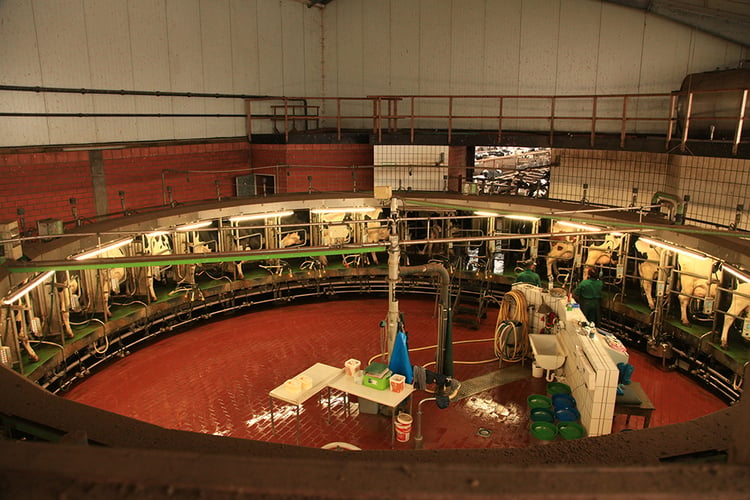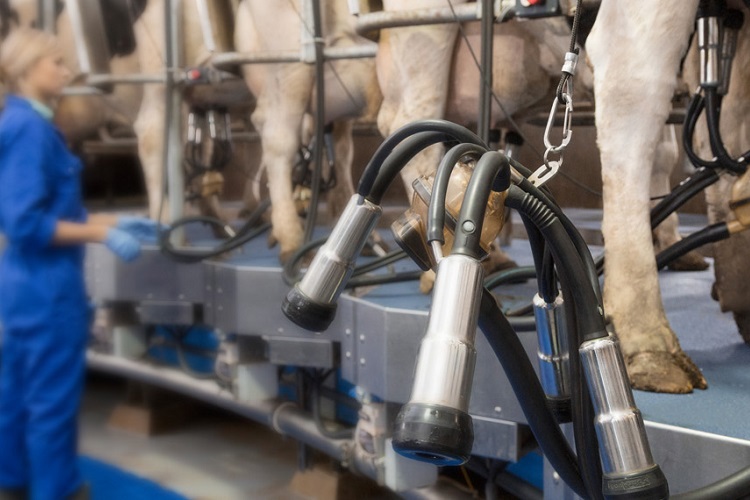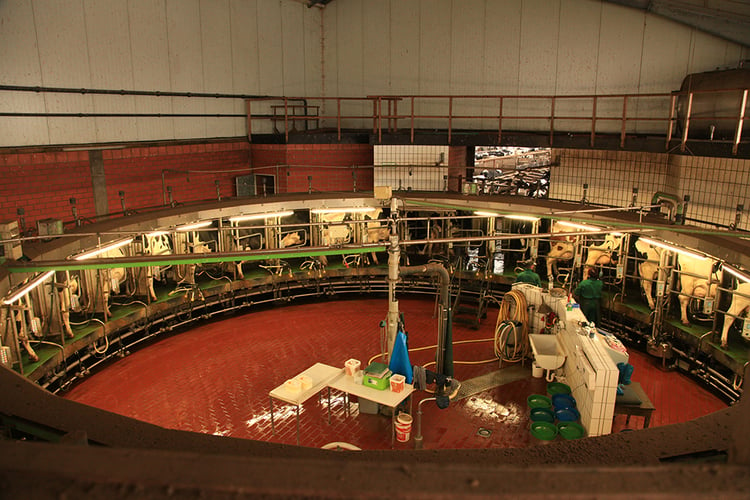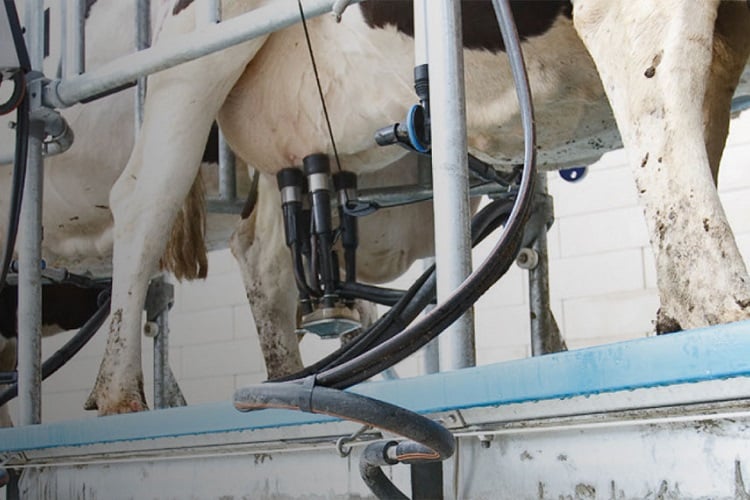- LifeStart
- First lactation
Key takeaways from the research:
- Respiratory disease at a young age has a negative and lasting impact on the growth
- The average daily gain in the first 2 weeks correlates positively with bodyweight at 6 months of age.
- The average daily gain in the first year has a positive correlation with first lactation yield but average daily gain between 9 and 12 months of age has a negative correlation with first lactation yield

First-year growth has a positive impact on production but growth between 9 and 12 months has a negative correlation with first lactation yield while respiratory disease reduces growth.
Research has shown that the quality of nutrition has a strong influence on pre-weaning growth[1,2,3,4,5,6,7,8,9,10,11] of dairy calves and milk production later in life[1,2,3,4,5,6,7,8,9,10,11]. Respiratory disease can however affect growth negatively[12]. Dr. Volkmann looked at the effect of rearing intensity and disease incidence on the future performance of German Holstein dairy calves[13].
Study design
A group of 2,252 Holstein dairy calves was fed colostrum ad libitum for the first 3 days of life, after which they were fed intensively in the period up to weaning at 9 weeks of age. The calves were weighed at 2, 6 and 9 weeks of age and subsequently every 2 months. Veterinary treatments against diarrhoea and respiratory diseases, first lactation milk yield and lifetime performance were recorded.
Results
Number of treatments for respiratory disease |
Number of calves |
Bodyweight at 6 months |
| 0 | 2.131 | 203 kg |
| 1 | 57 | 204 kg |
| 2 | 15 | 199 kg |
| 3 | 9 | 198 kg |
| 4 | 10 | 182 kg |
| 5 | 8 | 185 kg |
| 6 | 2 | 199 kg |
| 7 | 2 | 203 kg |
| 8 | 18 | 211 kg |
ADG Day 0-14 |
Number of calves |
Bodyweight at 6 months |
| 93 | 183 kg | |
| 100-300 g/day | 225 | 188 kg |
| 300-400 g/day | 242 | 193 kg |
| 400-500 g/day | 312 | 195 kg |
| 500-600 g/day | 431 | 198 kg |
| 600-700 g/day | 399 | 203 kg |
| 700-800 g/day | 219 | 207 kg |
| 800-1000 g/day | 183 | 208 kg |
| ≥ 1000 g/day | 67 | 208 kg |
ADG Day 0-365 |
Number of calves |
Bodyweight after 6 months |
| 297 | 8.966 kg | |
| 800-870 g/day | 468 | 9.158 kg |
| 870-925 g/day | 487 | 9.348 kg |
| 925-1000 g/day | 451 | 9.152 kg |
| ≥ 1000 g/day | 191 | 9.706 kg |
ADG Day 0-365 |
Number of calves |
Bodyweight after 6 months |
| 273 | 9.320 kg | |
| 625-775 g/day | 458 | 9.396 kg |
| 775-900 g/day | 508 | 9.314 kg |
| 900-1000 g/day | 475 | 9.324 kg |
| ≥ 1100 g/day | 180 | 8.973 kg |
Conclusion
It was concluded that weighing calves up to the age at which they are inseminated is very important. Calves should grow fast during the first 9 months of life but compensatory growth between 9 and 12 months of age should be avoided.
References
[1] Shamay, A., D. Werner, U. Moallem, H. Barash, and I. Bruckental. 2005. Effect of nursing management and skeletal size at weaning on puberty, skeletal growth rate, and milk production during first lactation of dairy heifers. J. Dairy Sci. 88:1460–1469.
[2] Faber, S. N., N. E. Faber, T. C. McCauley, and R. L. Ax. 2005. Case study: Effects of colostrum ingestion on lactational performance. Prof. Anim. Sci. 21:420–425.
[3] Morrison, S. J., H. C. F. Wicks, R. J. Fallon, J. Twigge, L. E. R. Dawson, A. R. G. Wylie, and A. F. Carson. 2009. Effects of feeding level and protein content of milk replacer on the performance of dairy herd replacements. Animal 3:1570–1579.
[4] Davis Rincker LE, VandeHaar MJ, Wolf CA, Liesman JS, Chapin LT and Weber Nielsen MS, 2011. Effect of intensified feeding of heifer calves on growth, pubertal age, calving age, milk yield, and economics. J. Dairy Sci 94:3554-3567.
[5] Moallem, U., D. Werner, H. Lehrer, M. Zachut, L. Livshitz, S. Yakoby, and A. Shamay. 2010. Long-term effects of ad libitum whole milk prior to weaning and prepubertal protein supplementation on skeletal growth rate and first-lactation milk production. J. Dairy Sci. 93:2639–2650.
[6] Raeth-Knight, M., H. Chester-Jones, S. Hayes, J. Linn, R. Larson, D. Ziegler, B. Ziegler, and N. Broadwater. 2009. Impact of conventional or intensive milk replacer programs on Holstein heifer performance through six months of age and during first lactation. J. Dairy Sci. 92:799–809.
[7] Drackley, J. K., B. C. Pollard, H. M. Dann, and J. A. Stamey. 2007. First-lactation milk production for cows fed control or intensified milk replacer programs as calves. J. Dairy Sci. 90(Suppl. 1):614 (Abstr.).
[8] Terré, M., C. Tejero, and A. Bach. 2009. Long-term effects on heifer performance of an enhanced growth feeding programme applied during the pre-weaning period. J. Dairy Res. 76:331–339.
[9] Soberon F, Raffrenato E, Everett RW and Van Amburgh ME. 2012, Preweaning milk replacer intake and effects on long-term productivity of dairy calves. J. Dairy Sci 95:783-793.
[10] Bar-Peled et al., 1997. Increased weight gain and effects on production parameters of Holstein heifer calves that were allowed to suckle from birth to six weeks of age. J. Dairy Sci; 80:2523-8.
[11] Bolt, A. 2019, Meta-analysis to calculate the effect of rearing intensity on functionality of dairy cows, Research paper Mecklenburg Vorpommern Landesforschungsanstalt für Landwirtschaft und Fischerei.
[12] Tejero, C., and A. Bach. 2016. The hidden cost of a hidden disease: growth performance of calves as affected by bovine respiratory disease diagnosed using ultrasonography. J. Anim. Sci. 94: 48.
[13] Volkmann, N, Kemper, N. and A. Romer, 2019. Impacts of prepubertal rearing intensity and calf health on first-lactation yield and lifetime performance, Ann. Anim. Sci; 19: 201-214.



